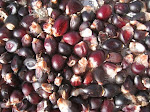
Hard-neck varieties of garlic produce a central stalk, or scape, that shoots straight up from the roots, through the middle of the bulb, and 3 or more feet into the air. As the garlic matures, the scapes dance and bend in graceful arcs and curly-cues. Soon they will straighten and harden into tough, unappetizing stalks. But right now, while still curly, they are tender and provide a delightfully subtle garlic flavor in salads, soups, stir-fries, and more.
A scape is something like a seed pod, but since garlic reproduces asexually, the scape does not contain true seeds, but rather little mini garlic cloves called bulbils. These can be planted and will produce more garlic plants, but they will be small. It takes several generations of replanting to get plants of the same size as the original, and so Henry grows next year’s garlic by saving back some of the mature cloves from this year’s crop, which he will harvest in the first week of July.
Superstar chefs are seriously into garlic scapes, but there are a lot of simple things to do with them.
Garlic Scape Ideas:
- sauté in butter and olive oil
- add sliced scapes to any stir fry recipe
- slice and sprinkle over any pasta; cook them in almost any sauce recipe
- great in guacamole and fresh salsa, too
- chop & add to softened cream cheese
- use them as you would green onions
- good in salads, on bruschetta, pizza
- an excellent addition to stocks
Roasted Garlic Scapes
Take the scapes and put them in a lightly oiled roasting pan. Sprinkle with sea salt. Put the covered pan in a hot (425 °F) oven for 30 to 45 min., or until scapes begin to turn brown. Serve as a side or main dish.



2 comments:
Thanks so much for this, Terra. I have never heard of eating the scapes before. Can you tell me if you eat the whole stalk? Or just the tops?
It depends on how mature the plant is. Right now, you should be able to eat the whole stalk . . . but soon it will begin to get woody, starting nearest the ground. If I encounter resistance when I'm cutting it, I just discard that lower portion and use the upper portion that is still tender.
Post a Comment